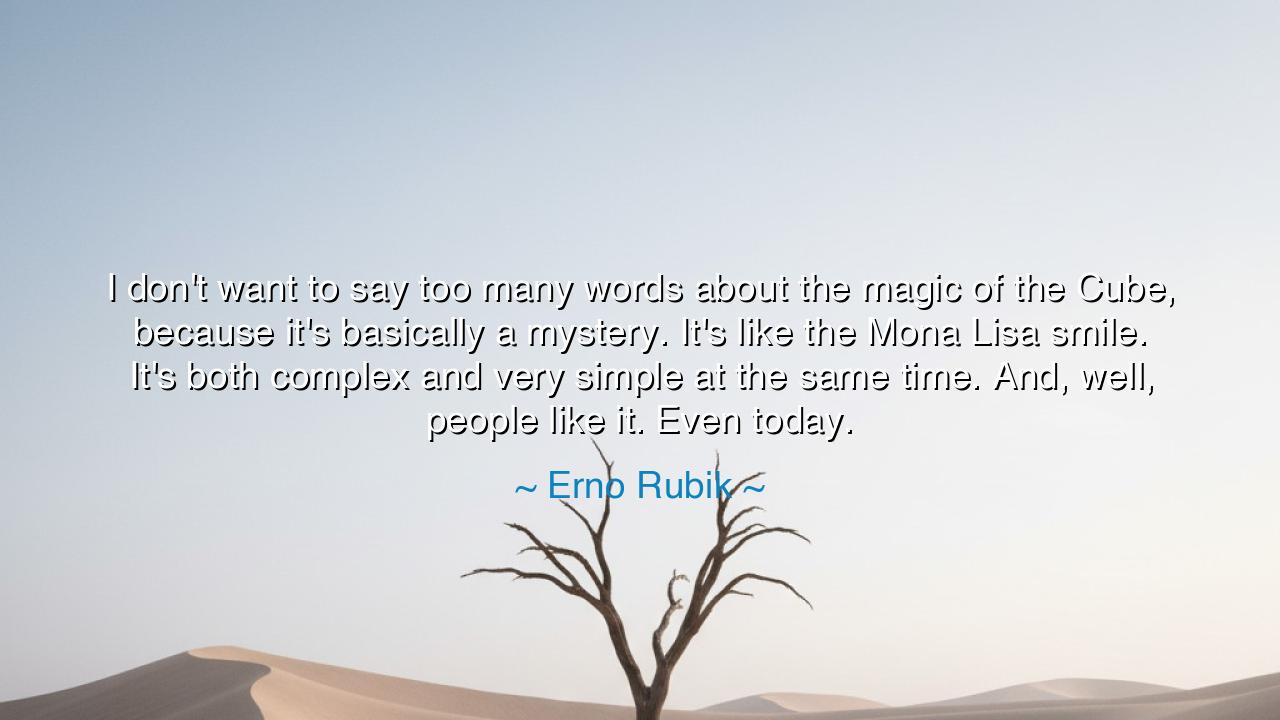
I don't want to say too many words about the magic of the Cube
I don't want to say too many words about the magic of the Cube, because it's basically a mystery. It's like the Mona Lisa smile. It's both complex and very simple at the same time. And, well, people like it. Even today.






Hear the words of Ernő Rubik, the quiet creator of one of the world’s most enduring puzzles, who declared: “I don’t want to say too many words about the magic of the Cube, because it’s basically a mystery. It’s like the Mona Lisa smile. It’s both complex and very simple at the same time. And, well, people like it. Even today.” These words reveal the heart of invention, the paradox of creation: that the greatest works of humankind are at once simple and complex, approachable yet unfathomable, ordinary to the eye yet infinite to the spirit.
The origin of this wisdom lies in Rubik’s own masterpiece—the Cube, that six-colored enigma known across the earth. What began as a tool to teach three-dimensional geometry became a symbol of both wonder and frustration, a puzzle that has challenged minds for decades. Like the Mona Lisa’s smile, the Cube resists explanation. It is a child’s toy and a philosopher’s riddle, a game and a study in infinity. Rubik himself acknowledges this mystery, understanding that the true power of creation lies not in dissecting its secrets, but in letting others marvel at its endless depth.
History reminds us that many of humanity’s treasures share this dual nature. Consider the Pyramids of Giza—stone upon stone, simple blocks stacked by countless hands. Yet together they form a mystery that endures through millennia, still inspiring awe and debate. Or the haunting smile of Da Vinci’s Mona Lisa, as Rubik himself invokes: brushstrokes of paint, no different from thousands of other portraits, yet arranged in such a way that the world has gazed at it for centuries, unable to define its meaning. So too with the Cube: small pieces of plastic, yet woven into something eternal.
The meaning of Rubik’s words stretches beyond invention into life itself. All of existence is like his Cube: complex and simple at once. The laws of the universe may be vast, intricate, layered with mystery, and yet life itself can often be reduced to the simplest truths—breath, love, joy, sorrow. The wisdom of the ancients has always reminded us that simplicity is not the absence of depth, but its truest expression. What is complex to the mind may be simple to the heart.
Rubik also reminds us that the measure of greatness is not whether we understand a thing, but whether we delight in it. “People like it, even today,” he says, and this is no small achievement. To create something that transcends its time, that is passed from hand to hand across generations, is to touch eternity. The Cube is more than a puzzle; it is a conversation across cultures, a reminder that the human spirit loves to wrestle with mystery, to struggle, to solve, and yet to never fully exhaust the wonder.
The lesson for us is clear: do not rush to explain all things, nor to strip mystery from the world. Some wonders must be left unsolved, their beauty lying in their endlessness. Just as Rubik does not over-speak of the Cube’s magic, so too must we allow certain joys, certain experiences, certain moments, to be cherished without dissection. To live fully is to embrace both the clarity of simplicity and the allure of mystery.
Practical action must follow. Cherish the puzzles of your own life—the questions without immediate answers, the mysteries that linger. Approach them not only with the desire to solve but with the willingness to marvel. When faced with challenges, remember the Cube: small in the hand, yet infinite in possibility. Smile at the paradox, as you might smile at the Mona Lisa, and know that some things are beautiful not because they are explained, but because they endure.
Thus the teaching is sealed: the greatest creations are both mystery and simplicity, both play and profundity. Ernő Rubik, with his humble Cube, has given the world more than a puzzle—he has given it a metaphor for life itself. So let us not fear mystery but embrace it, for in the smile of the unknown lies the eternal spark of wonder.






AAdministratorAdministrator
Welcome, honored guests. Please leave a comment, we will respond soon